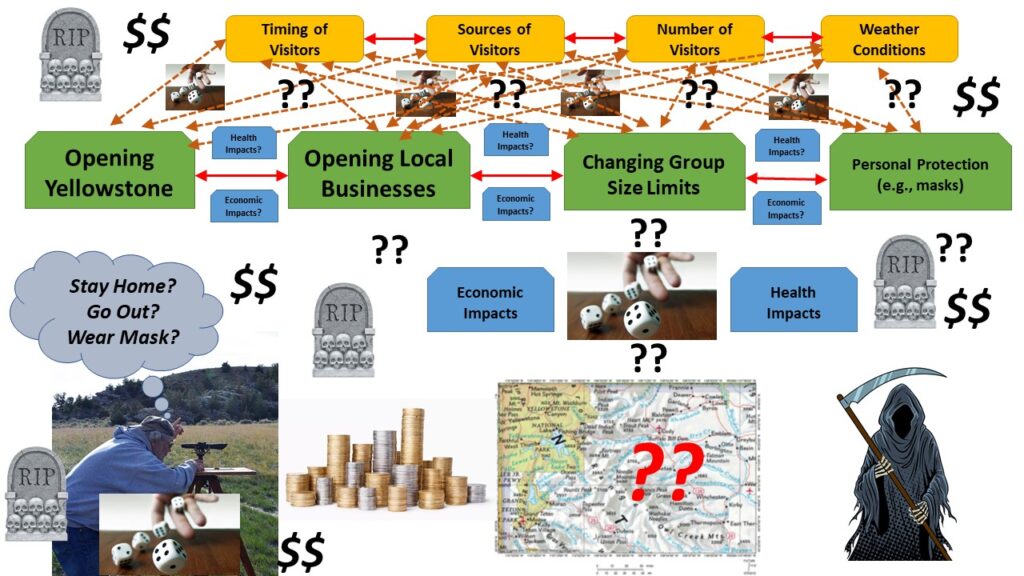The 2020 GRSLE field season was unusual. Not in terms of basic field methods or in reference to what we found. Teams coded nearly 6500 (N=6488) artifacts, mostly chipped stone (N=5083), but also with a few glass beads (N=12), ceramics (N=22), and steatite fragments (N=3) as well as assorted faunal remains and features. The key difference between 2020 and the 18 previous field seasons was the need to deal with Covid-19 – the need to employ field protocols and goals designed for team health rather than on research questions alone.
Continue reading “Don’t Burst Our Bubble”Greybull River Sustainable Landscape Ecology
It’s Fuel – Eat and Get Moving
After having taken first two steps toward getting ready for a 2020 field season (developed at COVID-19 safety plan and worked out what want to try to accomplish), can now turn to one of my least favorite but essential pre-field tasks. Getting the food. This has changed quite a bit during the GRSLE project from a team cooking approach with a fixed, planned menu1 to the current reliance on freeze dried food and individual food preparation. Changed from stoves and camp cooking to boil water, add to foil pouch, soak, and consume. I much prefer the new, quick and lean system, which it now based on several of my field food biases:
- Food is fuel, nothing more;
- Preparation time needs to be minimal – the working GRSLE rule is “if it takes more than 20 minutes to prepare, consume, and clean-up it’s a waste of field time”;
- Do everything possible to limit cooking smells, food waste, and garbage – “pack it in, eat it”.
Then, Then, and Now
The 2020 GRSLE field program will include revisiting sites that have been recorded before to assess how vegetation cover and artifact visibility have changed since the 2006 Little Venus Fire (LVF). In addition to sites, it will be a good opportunity to re-take photos of the general area impacted by fire.
Continue reading “Then, Then, and Now”2020 Fieldwork Plan
Plans for GRSLE 2020 fieldwork have changed considerably since first roughed out in December 2019. At that time, the focus of our work was going to be in a remote area of the Washakie Wilderness continuing the investigation of methods to assess prehistoric migration corridor routes. As Spring 2020 assaulted us and a new variable was added to the field planning concerns (COVID-19), until recently it looked like would not be conducting archaeology fieldwork with a team this summer. Too many fuzzy variables and concerns. But after having spent considerable time sitting on and sometimes falling off the fence, although there are still huge doses of uncertainty to deal with, finally was able to cobble together a COVID-19 field protocol for being able to give near-maximum protection (maximum protection would be no team fieldwork) for all team members.
Continue reading “2020 Fieldwork Plan”2020 Fieldwork – COVID-19 Protocols
Normally when getting ready for fieldwork am planning project areas, travel routes, thinking about how much Spam to buy. This year is different, have to throw thinking about taking responsiblity of protecting against COVID-19 into the mix. While it’s becoming second nature to think about being a grizzly aware camp and taking food and attractant storage precautions, this year have to work on being virus-aware (and as yet, no COVID-19 spray available). Here’s what are thinking about for field protocols for the summer 2020 field sessions. Sort of like any other archaeology project– get your basic research goals, field methods, and logistics designed and ready to to. Then prepare for dealing with all the other unexpected, “where did that come from contingencies” issues. Have done as much advance planning for trying to be COVID-19 aware as possible, but no doubt issues will come up that will require revising these virus-safe-as-possible plans.
Continue reading “2020 Fieldwork – COVID-19 Protocols”Waiting
So while waiting to figure out if will actual do fieldwork this summer, today was playing a bit with artifact weight and size data from assemblages from 48PA201, 48PA551, the Big Horn Canyon sites, and a couple others that Rachel Reckin and Jack Hofman and I have been recording. Had question about couple of our recorded artifact weights and couldn’t get back in to re-measure right away, so thought would play around with the numbers a bit (rainy day — over 50mm rain in last 30 hours) rather than go outside.
Continue reading “Waiting”Summer 2020
Unsure if will have a GRSLE summer 2020 field research program. Right now, too many variables without enough information for me to decide.







